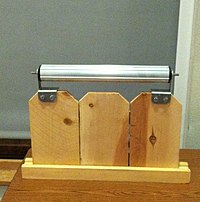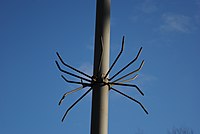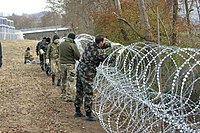Proposal:Anti-access Devices
| Anti-access Devices | |
|---|---|
| Proposal status: | Inactive (inactive) |
| Proposed by: | VileGecko |
| Tagging: | anti-access=* |
| Applies to: | |
| Definition: | Describes additional security measures to deter trespassers from accessing restricted areas |
| Statistics: |
|
| Draft started: | 2021-10-11 |
Proposal
This proposal is a work in progress! Do not use any part of it until properly discussed and voted!
It is proposed to introduce a new key anti-access=* which is mainly expected to be used in conjunction with barrier=wall, barrier=fence and barrier=gate however it may often be applied to other features such as building=*, man_made=utility_pole, man_made=pipeline and sometimes even natural=tree. Therefore this key may apply to nodes, ways, areas and multipolygons.
Rationale
Anti-access appliances like barbed wire or spikes can be found literally everywhere an need no additional presentation. While in the majority of cases such devices are appied to fences and gates there are quite a lot of instances where they are employed to prevent access to other objects such as buildings and infrastructure. This proposal is designed in a way so that the new values can be applied regardles of wheter a feature is a barrier=* or not.
Tagging
| Key | Value | Description | Photo |
|---|---|---|---|
| anti-access | no | Default value. Used to explicitly indicate that no additional security measures are present on a feature. | |
| anti-access | barbed_wire | One of the most common devices used to prevent trespassing. | |
| anti-access | razor_wire | Also known as barbed tape. Another common security device made of galvanised steel. * Google returns 49.9 million results for "razor wire" and 30.5 million results for "barbed tape" therefore the more common name was chosen. |
|
| anti-access | decorative_spikes | Commonly found on wrought iron and other metal fences and serve mostly decorative purpose. Spikes are relatively far apart and do not effectively prevent grabbing and climbing however can still cause serious injury if fallen upon. | |
| anti-access | spikes | More densely packed spikes which do not leave much room for grabbing or gaining a foothold. Sometimes may be part of fence decoration but clearly provide higher level of security than anti-access=decorative_spikes nevertheless. | |
| anti-access | razor_spikes | Mass produced spikes in the form of a galvanised steel band applied to horizontal surfaces. May come in different designs. | |
| anti-access | rolling_spikes | Highly effective device consisting of sharp spikes or razors attached to a rolling horizontal bar which cuts intruders and prevents grabbing. | |
| anti-access | rolling_obstacle | Device which is similar to the anti-access=rolling_spikes but does not cause injury. Consists a rolling horizontal bar often with rods or meshes attached to it. | |
| anti-access | electric | Current is either applied to electric wire or directly to some part of a fence itself. Current may vary from unpleasant on cattle fences to potentially deadly at high-security areas. | |
| anti-access | curved_top | Top of a fence is curved 90° or more to make climbing significantly harder. | |
| anti-access | grease | Surface is covered with grease or non-drying paint making it slippery and leaving a mark on a person touching it. Grease is usually applied above a certain height. | |
| anti-access | glass_shards | Improvised security measure consisting of glass shards cemented atop a wall. | |
| anti-access | nails | Cheap security measure sometimes applied to wooden fences. | Insert photo here |
| anti-access | thorns | Hedge consisting of dense spiky vegetation. This tag may also apply when such vegetation is deliberately planted near a feature to prevent climbing. Do not use this tag for isolated plants with thorns. |
|
| anti-access | collar | Harmless obstacle affixed on a vertical or horizontal surface to prevent climbig. If a device has sharp edges use one of the previously listed values instead. | |
| anti-access | <user-defined> | Another less common device not listed here. |
Combinations
Different anti-access appliances are often combined with one another with two or three kinds of devices used at the same time - creating proper separate tag for each possible combination does not seem practicable therefore it is proposed to use semicolon. Using an anti-access:*=yes/no tag for each appliance may prevent users from adding uncommon values and does not allow indicating that a feature lacks any security devices.
List all of the relevant values in alphabetical order separated with a semicolon without spaces. Examples of usage are provided below.
Examples
| Photo | Location | Tagging | Notes |
|---|---|---|---|
| Canada | barrier=fence fence_type=wire material=steel anti-access=barbed_wire |
Permanent farmland wire fence. | |
| Slovenia | barrier=fence fence_type=wire_obstacle material=steel anti-access=razor_wire |
A temporary concertina wire obstacle consisting almost entirely of razor wire. | |
| Netherlands | barrier=fence fence_type=bars material=steel anti-access=rolling_spikes |
Spiked bar prevents climbing over the fence. | |
| USA | building=yes amenity=prison anti-access=razor_wire |
Razor wire coils affixed onto the façade of a buildig. | |
| USA | power=tower structure=lattice material=steel anti-access=razor_spikes |
A transmission tower with anti-climbing bands applied to its lattice structure. | |
| UK | barrier=anti-access material=steel anti-access=collar |
A pipeline with two anti-climb collars. Apply tagging only to the nodes within the way of the pipeline. |
Rendering
The new barrier=anti-access tag should be rendered with a standard barrier grey dot symbol on zoom level 17 and above when used as a node and not rendered when used as a way (as it is only intended to be used on building area edges).
The key anti-access=* is not intended to be rendered on most styles.
Features/Pages affected
Key fence_type=* requires to be elaborated and cleaned up itself however the following changes are proposed alongside the main application:
| Photo | Key | Old value | New value | Description |
|---|---|---|---|---|
| fence_type | wire barbed_wire electric |
wire | Fence consisting of wires tightly strung between posts. This includes regular, barbed, razor or electric wire or any combinations thereof. Type of wire can be indicated with an anti-access=* tag if required. | |
| fence_type | wire | rigid_mesh | Lightweight mass-produced mesh made either of wires welded or clamped together or of metal sheet expanded into diamond patterns; some meshes are made entirely of razor wire - the tag anti-access=razor_wire should be additionnaly used with those. Extruded hard plastic mesh and other similar non-metal designs also qualify in this category. | |
| fence_type | barbed_wire | wire_obstale | Temporary or semi-permanent obstacle consisting almost entirely of barbed or razor wire coils or other volume arrangements typycally used for military or law enforcement purposes. Type of wire must be indicated with an anti-access=* tag. |
External discussions
Comments
Please comment on the discussion page.























